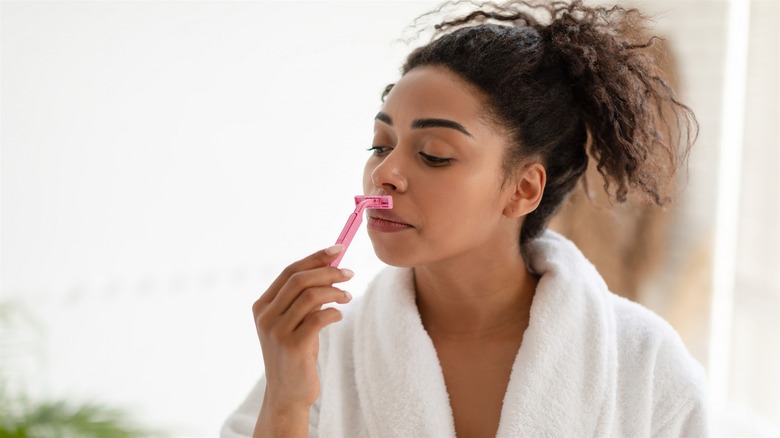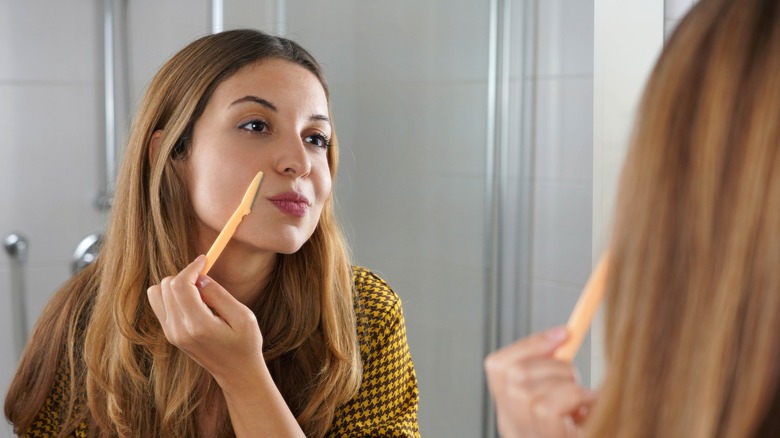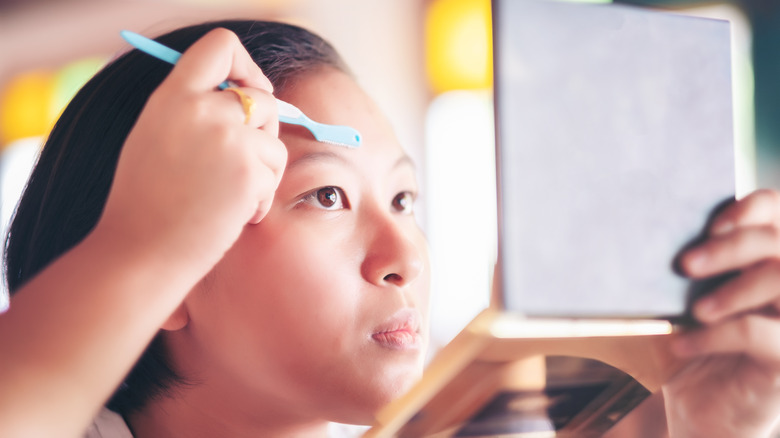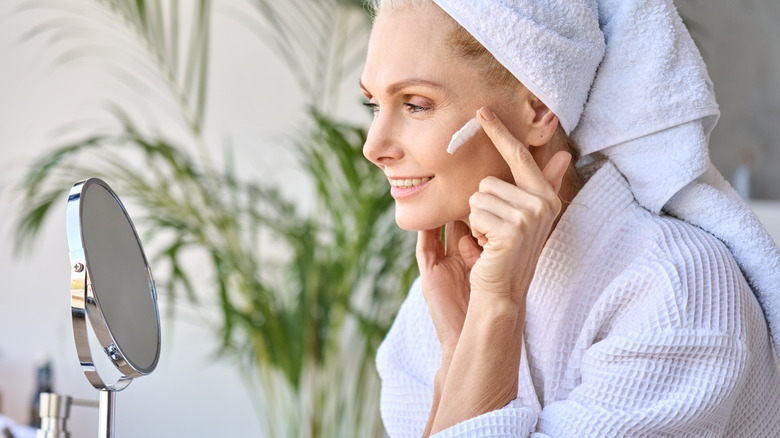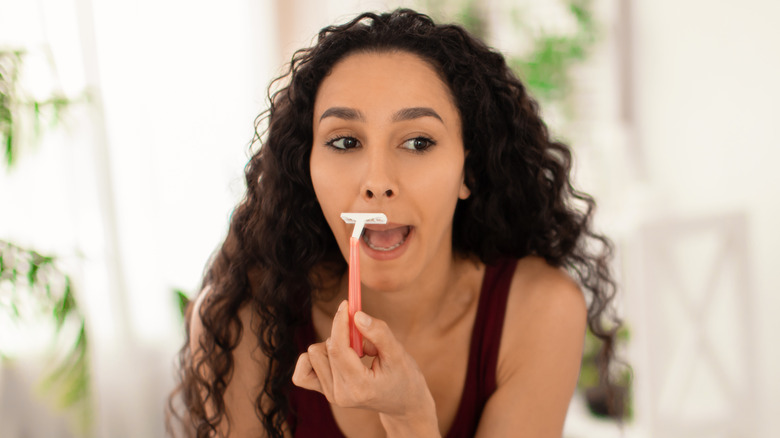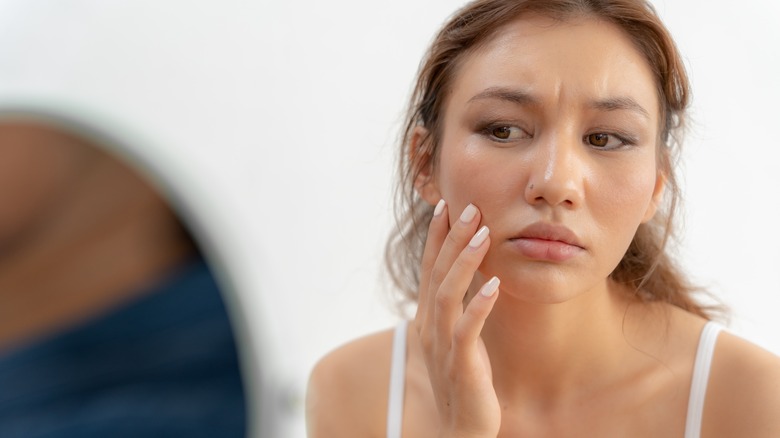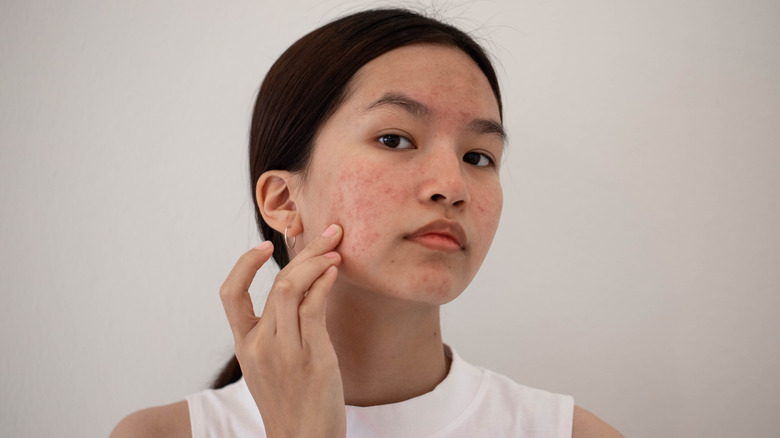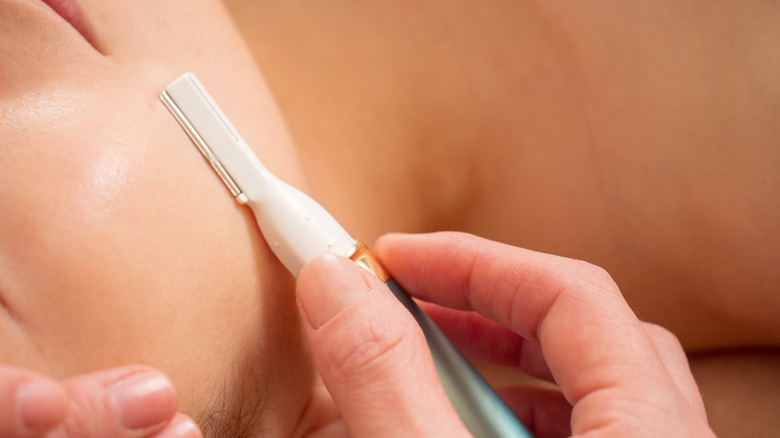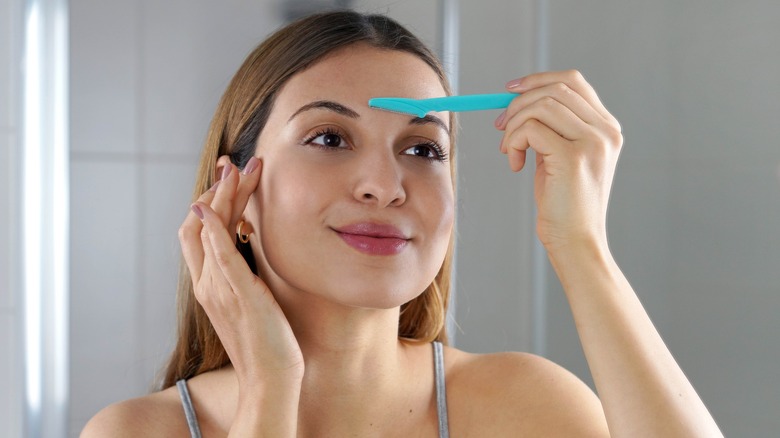When Women Shave Their Face, Here's What Really Happens
It's becoming increasingly common for women to shave their faces. Some women choose to use body razors, some face-specific razors, and others prefer to remove hair via dermaplaning. The concept has gone viral on social media, as more women begin opening up about what really goes into our hygiene and beauty routines. In fact, numerous celebrities have gone on the record to share their experiences. Amongst them? Eva Mendes, who shared a post on Instagram in June 2023 that showed her during a professional dermaplaning treatment (though it can easily be done at home, too).
"Shaving my face! ... Ok I guess 'dermaplaning' is the preferred word but it is what it is and I LOVE it!" she captioned the photos. Meghan Trainor and Kelly Clarkson also got real about the practice on "The Kelly Clarkson Show" that same month. "People don't talk about this," Clarkson said of female facial hair. "Let's talk about it."
Yes, Kelly. Let's. And we'll start at the beginning. So, what the heck actually is dermaplaning? Well, as dermatologist Dr. David Kim put it to The Wall Street Journal, "Dermaplaning is when you take a very gentle blunt scalpel and you scrape over the surface of your skin on the face or anywhere else on the body to gently exfoliate, to remove the thin hairs called vellus hairs and the outermost layer of the skin." There are a number of things that happen when you give dermaplaning, and regular face shaving, a try.
Your peach fuzz and stray facial hairs go away (at least temporarily)
The obvious immediate effect of shaving your face is that hair is removed. Almost all of us have those shorter, thinner hairs around our faces and lips. Technically, they're called vellus hair, but they're more commonly known as peach fuzz. Taking a small dermaplaning razor to them will get rid of that. Though your peach fuzz may not be totally visible in all lighting, just knowing those lingering hairs have been removed can act as a major confidence boost for many people who identify as a woman.
The same can be said for those lingering thicker hairs we all fall victim to. Let's be honest, almost all women get those single thick, dark hairs that seem to pop up out of nowhere around our mouths and on our chins. Shaving will make it harder for these to break through. Just like with our legs, regularly taking a razor to your face will keep cutting down on those stragglers before they even have a chance to be visible. Just remember, though, you should only ever be removing hair from your body because you want to — never for anyone else.
It's worth remembering, too, that shaving your face won't work miracles. Just like your legs, it won't banish unwanted facial hair for good. The only way to do that is to invest in permanent treatments like laser hair removal.
Facial hair stays the same (despite what you may have heard)
We've all heard those rumors that if you start shaving somewhere, the hair will grow back thicker, quicker, and darker. But we're happy to report that's just not true. When you start shaving your face, you aren't going to suddenly wake up a week later with a full-on mustache. We promise. It will only ever grow back the same as the first time you took a razor to the area.
"Contrary to popular belief, shaving has no permanent effect on the hair follicle. So vellum hair (fine hair on the face) does not grow thicker or darker after shaving," Dr. Oberoi confirmed to Times of India. "Shaving simply cuts the hair at an angle, leaving it looking blunt."
And we're not just talking about the thicker, individual hairs that pop up around the chin, either. As dermatologist Dr. Elizabeth Hale told The Cut, "With vellus hairs, you can't do anything to change them. By nature they're soft and fine, and shaving them won't make them thicker and coarser." There we have it.
Makeup looks better
Though often confused with the simpler act of shaving the face, dermaplaning is actually more of an exfoliating technique and is done with a sharp, small blade. The tool looks a little like a small butter knife. As we know, it's great for getting rid of any peach fuzz on your face. That, in turn, will make your makeup application much smoother, which means better-looking makeup.
The science behind this one is that those pesky fuzzy hairs can really grab hold of makeup and make it look clumpy and dry. Not to mention it can trap germs on your face. "While those soft, vellus hairs can be helpful, they also hold onto makeup, dirt, bacteria and a whole bunch of irritants," skincare expert and medical esthetician Cassandra Bankson told USA Today. "I found that when I dermaplaned my face, my selfies turned out crisper, because the powdered makeup wouldn't hold onto my facial hairs."
Peach fuzz can also add extra texture to the face, which isn't what we want when it comes to flawless makeup application. Not to mention, by removing those unwanted hairs, more of your skin will be able to shine through. That may mean your skin will look generally brighter and more glowy, as your powder, cream, or liquid products will no longer be fighting to be seen under all that peach fuzz.
Skincare products soak in better, too!
It's not only your makeup that will be in top form after a dermaplaning or face-shaving session. As we know, dermaplaning has its uses in exfoliating the skin as well as removing hair. "Dermaplaning is actually a superficial exfoliation treatment, and a removal of vellus hair is a positive side effect of this treatment," Maja Swierczynska, dermaplaning trainer explained to Healthline. The technique also helps to remove any dull and dead skin cells, which means the skin is able to better absorb anything that's being put onto it. "Any form of exfoliation can help skincare products sink in better because it reduces the barrier," dermatologist Dr. King confirmed to Wing It Cosmetics.
But even if you prefer to simply put a razor on your face rather than undergoing a dermaplaning session, your skincare products will still have the added benefit of being able to enter straight into the skin without a barrier of peach fuzz. And that will instantly help improve your skincare's effectiveness as well.
It's not just about home skincare products working better, though. Treatments like facials can also work better after removing facial hair. As Dr. Elizabeth Hale told The Cut, "I think [dermaplaning] also taps into this whole new field in dermatology which is all about increasing efficacy and penetration of topical ingredients."
Skin can look generally improved all over
You know those times when your skin just looks ... better? You can't quite put your finger on what it is, but it's glowing. Well, it's thought shaving your face regularly can help with that. Of course, there are benefits to regular exfoliation, but skin has also been known to look better overall after shaving.
That's partly because regularly getting rid of hairs and dead skin can potentially make the skin appear both cleaner and brighter while collagen production can even be stimulated. "Exfoliating increases cell turnover, which in turn leaves you with a fresher appearance," plastic surgeon Dr. Jennifer Levine told Teen Vogue, referring specifically to dermaplaning. Without all that peach fuzz, skin can also feel and look smoother.
There's also been chatter that regular shaving can even help reduce the appearance of lines and wrinkles on the face. "One reason men are thought to get fewer wrinkles is that they're constantly exfoliating their faces every time they shave, literally shaving away the outermost layers of skin and encouraging your skin to create new layers," Alexis Wolfer, editor of The Beauty Bean, told ABC News. Hey, it sounds good to us. All that, plus better-looking makeup and added skincare effectiveness? Not bad at all.
Stubble and a five o'clock shadow could form
Shaving your face comes with drawbacks too, though. Because it's not all that different from shaving your legs, you can experience many of the same shaving side effects, but in an even more sensitive area. One of the biggest is the feeling of prickly stubble. While peach fuzz hairs tend to be light enough that the re-growth isn't particularly noticeable, women who have slightly thicker hairs around the face may notice a feeling of stubble after shaving.
But that's not all. Some women have also been to develop a five o'clock shadow after shaving the face, particularly those who have darker, thicker hair. If shaving the face is done regularly enough, stubble shouldn't have much of a chance to develop — but keeping up with the cycle may force some women to shave their faces more regularly than they may wish to.
Pre-existing skin conditions might be triggered
Those with sensitive skin, or skin conditions such as eczema or rosacea, need to practice extra caution when shaving the face, as the practice can easily make pre-existing skin conditions flare up. "You need a strong skin barrier so if you have dry skin, or flaking red skin [dermaplaning is] not a great treatment. It can worsen skin conditions or flare them up," cosmetic dermatologist Dr. Azadeh Shirazi explained to USA Today. That's why it's important to have a chat with your doctor or dermatologist before trying anything new, particularly if you're planning to shave your face or try DIY dermaplaning at home.
People of different ethnicities can also be more prone to the downsides. People of Asian descent, for example, may be more prone to irritated skin. "Compared with Caucasians, Asians tend to have a thinner stratum corneum, so our skin may become more sensitive to chemicals in skincare or sunlight as a result of overscraping," Dr. Georgia Lee, medical director of TLC Lifestyle Practice Clinic, told Her World.
To avoid potential irritation, make sure your razor or dermaplaning blade is properly sanitized before you start, and begin with a clean face. It's also super important to do your research first so you know what tools will work for you and what tips and tricks to follow. "Be informed about dermaplaning, the dos and don'ts, the techniques, because the more you know, the better you can assess the risks," Dr. Shirazi advised.
Breakouts could become inflamed
Those with skin that's prone to breakouts will also want to be especially careful with it comes to shaving the face. It goes without saying that dragging a blade over skin that's already sore or rife with acne probably isn't going to make it feel soothed. Though shaving the face may not actually cause breakouts itself, it could irritate existing acne or introduce bacteria into any open wounds. It can also disturb whitehead blemishes, leaving them red, sore, or even bloody.
To help avoid painful blemishes and acne irritation after shaving your face, try shaving following a shower while your face is still wet and clean. It may also be worth investing in a sensitive shaving foam or gel to help the blade glide better across the skin, and remember to shave with the grain of the hair while trying your best to avoid any blemishes.
Dermaplaning with sensitive or acne-prone skin has its dangers, too. Though it's quick and easy to try at home, most professionals recommend getting a professional treatment if you have any skin issues. That's because dermaplaning has been known to cause skin irritation and breakouts in some people, so is best monitored by a professional in a sanitary environment.
The skin is left open to infections
As with any kind of skin treatment, if steps aren't taken to ensure things are sanitary and safe, you could leave yourself open to serious infections. Shaving your face with a razor or any other kind of blade leaves you susceptible to cuts, which can easily let in bacteria. One of the biggest dangers associated with shaving is sycosis barbae, in which the whole hair follicle gets infected.
Shaving can also lead to sore razor bumps, which are known in the medical world as pseudofolliculitis barbae. This happens when the prickly hair turns back into the skin. Ouch! Not to mention, shaving can also cause ingrown hairs and dermatitis, which can be painful if not properly cared for. To help prevent these side effects, shave against the grain of the hair with a clean, sharp razor and remember not only to clean your razor after each session, but also rinse it after each individual stroke on the face.
There are similar risks associated with dermaplaning, particularly at home. "In my opinion, one of the biggest dangers is that dermaplaning blades became available online. Without knowing the correct technique, such as the right angle and how you should hold the blade, you can easily cut the skin and this can lead to infection," Maja Swierczynska told Healthline. Always contact your doctor or dermatologist if you notice prolonged irritation on your skin after shaving or dermaplaning.
There's a new beauty expense and skincare routine step
With regular face shaving comes yet another expense added to your beauty routine (as if we don't already spend enough on beauty, right?) How often shaving needs to take place to keep the face fuzz-free varies from person to person, but it's recommended that women shave their faces every two to three days.
To avoid the dangers and make sure you're staying safe and sanitary, that could end up resulting in a lot of razors needing to be purchased over the year. And that can get pretty pricey. A pack of four Sephora brand facial razors (we'd 100% recommend using face-specific razors over a typical body razor) will cost you around $12 plus tax. As for a dermaplaning session, that could set you back anywhere between $75 and $150 per session, with some clinics even charging upwards of $250 for an appointment.
But it's not just the monetary expense. There's also the added time it takes to remove the hair from your face (although shaving your face at home does tend to be quicker than other hair removal techniques such as waxing, and dermaplaning doesn't require any downtime). Still, while there's no doubt this extra step is worth it for many women, it can get costly and time-consuming pretty quickly.
